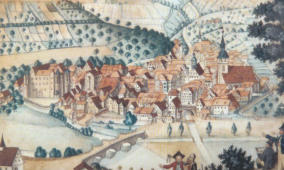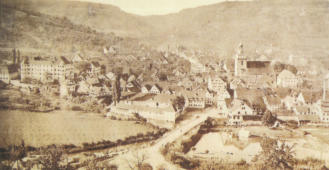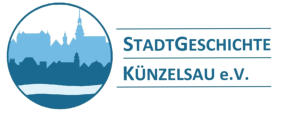
22

Hohenlohe and Künzelsau became part of Württemberg.
Following the foundation of the Kingdom of Württemberg by Napoleon
and the ensuing "mediatisation", most of the territories of the previously
imperial Hohenlohe principalities (including the town of Künzelsau)
were assumed into the new Kingdom of Württemberg (except
Hohenlohe-Schillingsfürst, which went to the Kingdom of Bavaria).The
properties of the regional imperial knights (for example those of the von
Stetten barony) were also assumed into the Kingdom of Württemberg,
which became an integral part of Napoleon's newly formed
Confederation of the Rhine. This was the final blow to end the Holy
Roman Empire of the German Nation.
The Ganerben had not only an important influence on the history of
Künzelsau, but also on its buildings. Several of the original
administration buildings can still be seen today in good condition in the
centre of the town.
King Friedrich of Württemberg awards Künzelsau the status of
Oberamtsstadt (centre of district administration), which was
previously held by the neighbouring town of Ingelfingen.
At the insistence of the citizens of Künzelsau, a secondary school
was established which, in addition to Latin, Greek and French,
also taught Mathematics, Geometry, Technology, Geography and
History.
Revolution also in Künzelsau The aim of the failed revolution was
to combat the despotism of the noble ranks and to achieve more
freedom. The recommendation of citizens from Künzelsau to the
first free German parliament in Frankfurt / Main was :"Moderate
socialists - remain steadfast; extreme socialists - become more
moderate; extreme conservatives - improve yourselves"
Birth in Künzelsau of Karoline Breitinger, the first woman doctor
in Württemberg. Her dissertation was presented in Bern in 1896
and she finally received her approbation after a long and arduous
legal battle in 1909. She so became the first practicing woman
doctor in Württemberg and was also active in the female
emancipation movement.
The river Kocher in Künzelsau was defined as part of the demarcation
line in the Austro-Prussian War. One anecdote relates the story of some
Prussian soldiers who crossed this line into Künzelsau to enjoy the
wine and the girls narrowly escaped from the tavern through the
windows.
The Hohenlohe nobles sold the castle in Künzelsau to the
Kingdom of Württemberg.In 1873 a teachers seminary was
established in the building; today it houses a secondary school,
the Schlossgymnasium.
The railway reaches Künzelsau, financed by the citizens of the
town. Long awaited since 1844, the decision was finally approved
once the community agreed to purchase the necessary land
themselves. Passengers were carried until 1981 and goods until
1991, when the rail link was finally closed.
The world's first motorised post bus started service in
Künzelsau.This was a technical pioneering feat, financed by a
private company. For a year the Benz bus travelled between
Künzelsau and Mergentheim, until technical problems forced the
return of the old post coach. However, Carl Benz had gained
valuable knowledge from this experience which he used to
advantage in the development of the omnibus.
Garnberg is officially incorporated into Künzelsau; as religious
parishes they had always been united.
The population of Künzelsau suffered the loss of 89 townsmen who
served during the First World War. They are named on a memorial in
the town cemetery. If the losses of the surrounding towns are included,
the figure rises to 150 lives.
Nagelsberg, the nearby hilly village originally belonging to the
Archbishopric of Mainz, was officially incorporated into
Künzelsau, since some of the Nagelsberg areas were needed for
the industrial expansion planned for Künzelsau.
Destruction of the Künzelsau synagogue by SA troops during the
Reichspogromnacht.After their first expulsion in 1580/81, Jewish
families had resettled in Künzelsau and Nagelsberg in the 18th and
19th centuries and built the synagogue in 1907. This tolerant
integration was completely reversed by the national-socialistic
dictatorship. Almost 50 of Künzelsau's Jewish men and women died
during the NS period, many of them in the concentration camps. Only
one Jew survived in Künzelsau as a forced labourer during those
twelve terrible criminal years of the "Thousand Year Third Reich"
Künzelsau was spared from heavy air attacks during the Second
World War. Following negotiations between courageous citizens and
the advancing US troops, the town was handed over virtually
undamaged in April 1945. Only a few houses had been damaged by
artillery fire prior to the negotiations. However, the population suffered
considerable personal losses during the war years. The local cemetery
records 233 deaths and 64 missing in action; if the outlying villages are
included the figures rise to over 300 deaths and over 100 missing in
action.
A direct result of the war started and lost by Nazi Germany was
the arrival and successful integration of many refugees and
expelled families from the German regions and in Central and
Eastern Europe which had been settled up to 1945: Population of
Künzelsau in 1931: 3,150 and in 1951: 5,250. Künzelsau and
Germany experienced a remarkably positive economic
development following the monetary reform in 1948 and the
introduction of the Deutschmark. Künzelsau profited from the
success of existing and newly established family companies,
many of which have advanced today to become world market
leaders in their field.
1806
1811
1830
1848
1851
1866
1871
1892
1898
1912
1914
-1918
1937
1938
1939
- 1945
after
1945




Town History - Time Line


<


















